For the options provided, I would pick "Create one chatbot and add it to three Teams channels that are configured for the local language" and "Publish the chatbot to the mobile app channel"
You are creating a business rule to implement new business logic.
You must apply the business logic to a canvas app that has a single screen named Screen1.
You need to configure the scope for the business rule.
Which scope should you use?
b
Note: Some terminology has changed. Entity is now Table. If you're building a Canvas app, you must use table (entity) as the scope.
Reference:
https://docs.microsoft.com/en-us/powerapps/maker/common-data-service/data-platform-create-business-rule
HOTSPOT
You are a system administrator for a company with locations in Mexico, United States, and France. The company has both fulltime employees and contractors in all regions. Fulltime employees use a mobile app. The company has two security groups: fulltime employees and contractors.
The company requests a chatbot in Microsoft Teams to answer employee benefit questions. The chatbot must meet the following requirements:
It must be in the local language.
Only fulltime employees may access the chatbot.
You need to configure the chatbot.
What should you do? To answer, select the appropriate options in the answer area.
NOTE: Each correct selection is worth one point.

For the options provided, I would pick "Create one chatbot and add it to three Teams channels that are configured for the local language" and "Publish the chatbot to the mobile app channel"
Create one chatbot and add it to three Teams channels that are configured for the local language also publish chatbot to mobile app channel
You create and publish a Power BI report that contains an embedded canvas app. The report will be used by multiple people.
The canvas app has an issue that must be corrected.
You update the canvas app.
You need to ensure that the updated canvas app is available in the published Power BI report.
What should you do?
a
If you change the data fields associated with the visual, you must edit the app from within the Power BI service by selecting the ellipsis (...) and then selecting
Edit. Otherwise, the changes won't be propagated to Power Apps, and the app will behave in unexpected ways.
The Power Apps visual can't trigger a refresh of Power BI reports and Power BI data sources from within Power BI Desktop. If you write back data from the app to the same data source as the report, your changes won't be reflected immediately in Power BI Desktop. Changes are reflected on the next scheduled refresh.
Reference:
https://docs.microsoft.com/en-us/powerapps/maker/canvas-apps/powerapps-custom-visual#limitations-of-the-power-apps-visual
Think it's B
this guy knows what he's talking about
The answer is B
HOTSPOT
A company uses Power Apps. You enable auditing in Microsoft Dataverse.
Users report the following issues when viewing the audit logs:
Unable to view the read access audit logs.
Unable to view the Account table audit logs.
You need to troubleshoot the issues.
What are the causes of the issues? To answer, select the appropriate options in the answer area.
NOTE: Each correct selection is worth one point.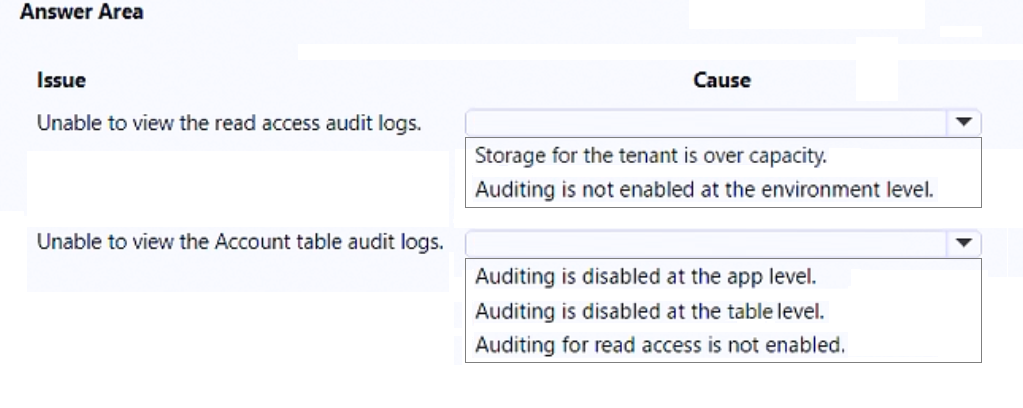
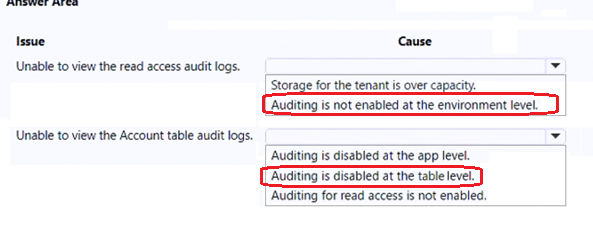
"Auditing is not enabled at the environment level" and "Auditing is disabled at the table level"
"Auditing is not enabled at the environment level." and "Auditing is disabled at the table level."
DRAG DROP
This is a case study. Case studies are not timed separately. You can use as much exam time as you would like to complete each case. However, there may be additional case studies and sections on this exam. You must manage your time to ensure that you are able to complete all questions included on this exam in the time provided.
To answer the questions included in a case study, you will need to reference information that is provided in the case study. Case studies might contain exhibits and other resources that provide more information about the scenario that is described in the case study. Each question is independent of the other questions in this case study.
At the end of this case study, a review screen will appear. This screen allows you to review your answers and to make changes before you move to the next section of the exam. After you begin a new section, you cannot return to this section.
To start the case study
To display the first question in this case study, click the Next button. Use the buttons in the left pane to explore the content of the case study before you answer the questions. Clicking these buttons displays information such as business requirements, existing environment, and problem statements. If the case study has an All Information tab, note that the information displayed is identical to the information displayed on the subsequent tabs. When you are ready to answer a question, click the Question button to return to the question.
Background
Bellows College is a post-secondary school that wants to start a football team. The college uses Microsoft Power Platform to manage its recruiting efforts. The registration team and assistants use model-driven apps. The coaches use canvas apps on their mobile devices.
Prospects are considered underage if they are younger than 18 years old at the time of registration.
Current environment
Environment
Custom code is not allowed in the system.
Server-side synchronization is configured for emails, appointments, contacts, and tasks.
The database and file storage of Dataverse must be minimized to keep costs low.
Contact table
Birthdate is a custom date and time field.
Age at Registration is a calculated field that displays the age of the prospect at the time of registration.
Current Age is a calculated field that displays the age of the prospect based on the current date and time.
Evaluation table
The Evaluation table is a custom table used to track evaluation criteria.
Evaluation records cannot be manually created.
Users must not be able to continue until an evaluation record is created automatically for the prospect.
Consent table
The consent forms completed by the parents are stored as records in the Consent table.
Occasionally, a parent cannot complete the consent online and a paper copy must be printed. The signed copy must be scanned and stored with the consent record.
Team website
The team website is created by using Power Pages.
A starter layout template was used to create the site.
The site consists of five pages:
o Home: A page open to everyone to view the announcements from the team.
o Schedule: A page open to everyone to view the tryout and game schedule.
o Evaluations: A page that displays tracking from the evaluation table. Prospects are able to view their own information only.
o Forms: A page that displays the consent form.
o Contact Us: A page for anyone to submit questions and comments.
Two web roles for authenticated users are created: Primary Contact User and Prospect User.
o All primary contacts and prospects are assigned to their respective roles.
Requirements
Registration
Parents and prospects are created as contacts and must be linked.
The registration team must be able to rapidly create prospects without navigating away from the Parents form. Only the First Name, Last Name, and Birthdate fields should be displayed for the team.
Assistants must be able to update prospect information and add teams that the prospect has previously played on to a subgrid.
Parental consent
When a prospect is underage, a Primary Contact field will appear. The field must be populated before the prospect record can be saved.
A view named Underage Prospects that lists all underaged prospects is required.
The Underage Prospects view must run once a week without requiring modifications to display correct information.
A consent email must meet the following requirements:
o be sent to the primary contact of each new underage prospect
o contain a link to the team website
o be automatically sent weekly and tracked to the contact record in Dataverse
o include the current date using the full month name, date, and year
Evaluations
Coaches rate prospects each day on a scale of 1-10 in three categories: endurance, coordination, and skill.
The total of the three categories is displayed at the bottom of the form. If the total for the day is greater than 25, the number should appear green.
You need to set up webpage permissions.
Which permissions must you set? To answer, move the appropriate permissions to the correct page. You may use each permission once, more than once, or not at all. You may need to move the split bar between panes or scroll to view content.
NOTE: Each correct selection is worth one point.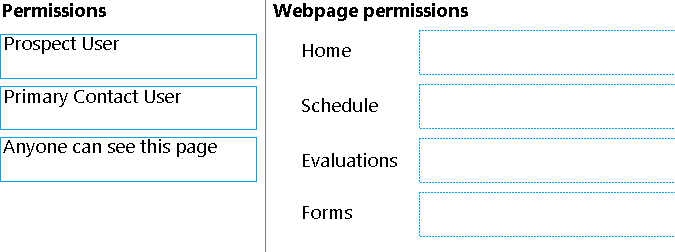
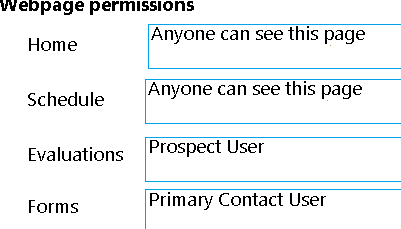
You have a canvas app that allows users to view, select, and purchase products. The app uses a Gallery control to display products and checkboxes that allow users to select products.
When users select items from the product catalog, they move to a different screen to complete a purchase.
Users must be able to clear all product selections when they click the button.
You need to configure the button.
What should you do?
a
Correct answer must be A, as in question it says need to configure a button whereas Oncheck and OnUnCheck are checkbox properties.
To configure the button to clear all product selections in your canvas app, you should use the Reset(Control) formula. This formula will reset the Gallery control and clear all selections.
The correct answer is D
DRAG DROP
A company has a model-driven app.
The app must meet the following requirements:
Prevent users from saving a record if validation from a custom action fails.
Query and update a list of records.
You need to configure processes for the app without using code.
Which processes should you use? To answer, drag the appropriate processes to the correct requirements. Each process may be used once, more than once, or not at all. You may need to
drag the split bar between panes or scroll to view content.
NOTE: Each correct selection is worth one point.

A company uses Microsoft Teams. You plan to create a Power Apps app for Microsoft Teams.
You need to determine the environment that will used by the app.
Which environment will the app use?
d
The Dataverse for Teams environment is automatically created for the selected team when you create an app or bot in Microsoft Teams for the first time or install a Power Apps app from the app catalog for the first time. The Dataverse for Teams environment is used to store, manage, and share team-specific data, apps, and flows. Each team can have one environment, and all data, apps, bots, and flows created with the Power Apps app inside a team are available from that team's
Dataverse for Teams database.
Reference:
https://docs.microsoft.com/en-us/power-platform/admin/about-teams-environment
The correct answer is D
HOTSPOT A guest asks about the start time of a specific scheduled event and wants to know what the snow conditions will be like during their stay.
You need to determine how to design the chat solution to answer those questions.
What should you do? To answer, select the appropriate options in the answer area.
NOTE: Each correct selection is worth one point.
Hot Area: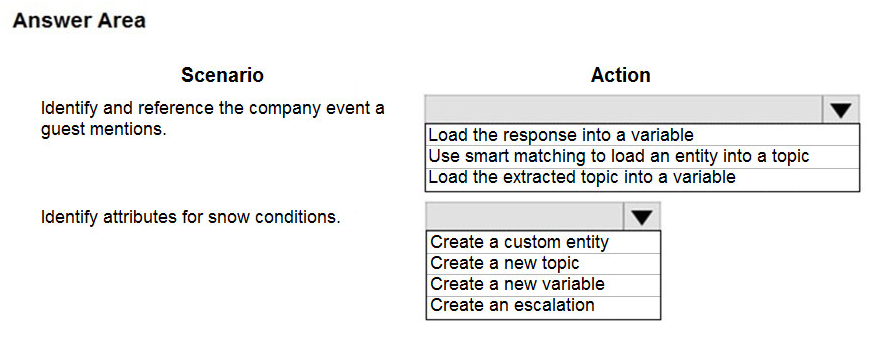
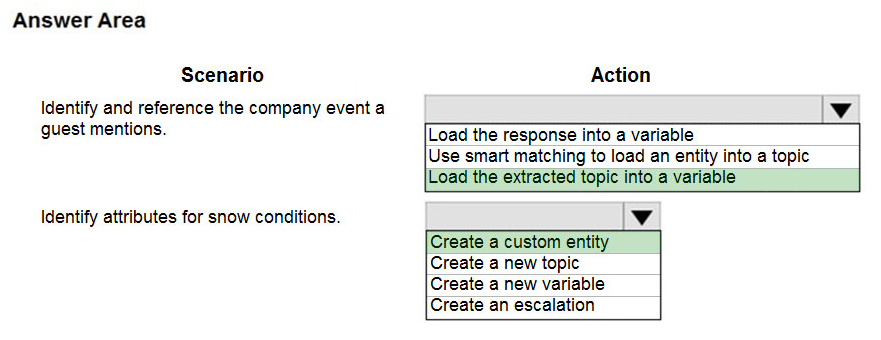
Box 1: Load the extracted topic into a variable
Power Virtual Agents uses entities to understand and identify a specific type of information from a user's responses. When saving the identified information to a variable, a variable type will be associated with it. The variable type is analogous with the entity.
In Power Virtual Agents, a topic defines a how a bot conversation plays out.
A topic has trigger phrases these are phrases, keywords, or questions that a user is likely to type that is related to a specific issue and conversation nodes these are what you use to define how a bot should respond and what it should do.
Box 2: Create a custom entity -
The prebuilt entities cover commonly used information types, but on some occasions, such as when building a bot that serves a specific purpose, you'll need to teach the bot's language understanding model some domain-specific knowledge.
Reference:
https://docs.microsoft.com/en-us/power-virtual-agents/advanced-entities-slot-filling
"Use smart matching to load an entity into a topic" and "Create a custom entity"
You must create a new entity to support a new feature for an app. Records for the entity must be associated with a business unit and specify security roles for the business unit.
You need to configure entity ownership.
Which entity ownership type should you use?
a
Dataverse supports two types of record ownership. Organization owned, and User or Team owned. For security purposes, records that are organization owned, the only access level choices is either the user can do the operation or can't. For user and team owned records, the access level choices for most privileges are tiered Organization, Business Unit, Business Unit and Child Business Unit or only the user's own records. That means for read privilege on contact, I could set user owned, and the user would only see their own records.
References:
https://docs.microsoft.com/en-us/power-platform/admin/wp-security-cds
Apply on Entity level
The answer is B
B is the correct
Correct is entity
B is the correct answer